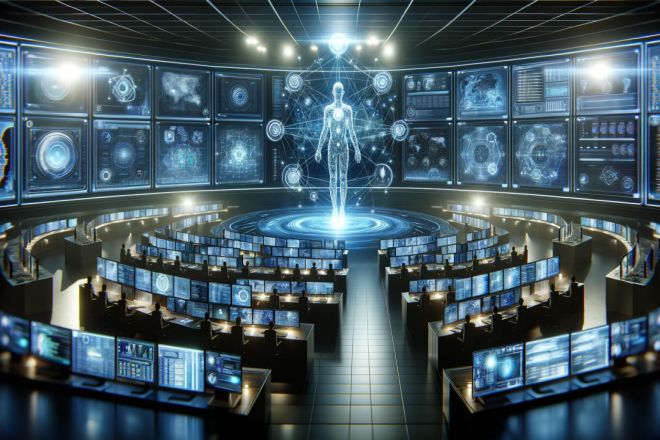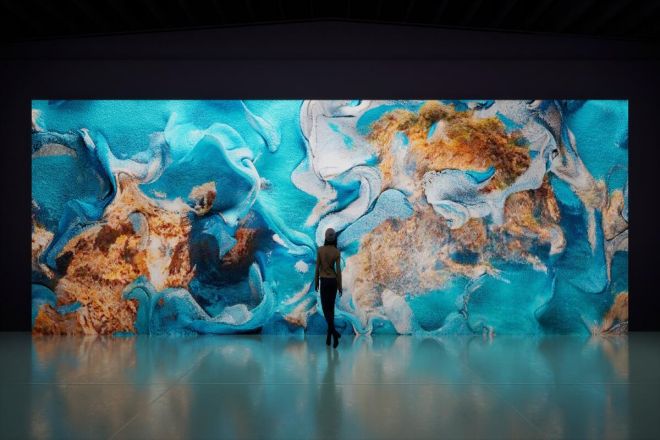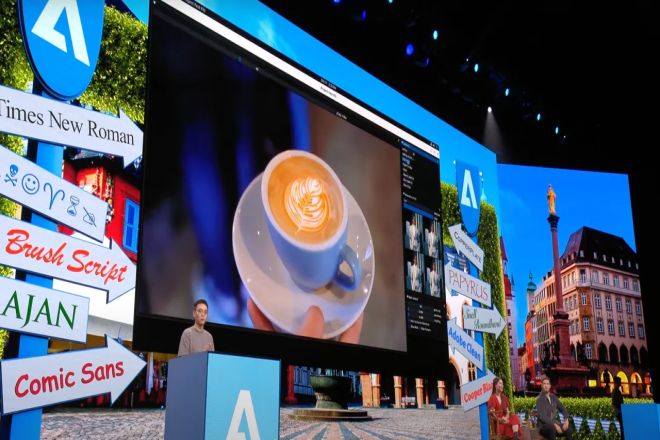소개

번화한 거리를 걷다 보면 광고가 눈에 띄는데요. 발광 다이오드 표시 스크린 당신의 마음을 읽고 당신이 가장 관심 있는 콘텐츠를 정확하게 추천해주는 것 같습니다.
또는 경기장에 들어서면 LED 대형 화면이 즉시 몰입감 넘치는 게임 장면으로 안내하여 모든 신나는 순간을 느낄 수 있습니다. 이 모든 것은 지능형 AI와 LED 디스플레이 화면의 긴밀한 통합 덕분입니다.
이 글에서는 최첨단 분야의 신비를 심도 있게 탐구하고, 지능형 AI가 LED 디스플레이 화면에 어떻게 날개를 달아 단순한 시각적 표시 도구에서 개인화되고 지능적인 정보 교환 플랫폼으로 변모시킬 수 있는지 밝힙니다.
우리는 기술의 원리를 분석할 뿐만 아니라 다양한 적용 시나리오도 보여드려서 이러한 통합이 우리의 일상 생활과 비즈니스 모델을 어떻게 바꾸는지 직접 목격하실 수 있도록 하겠습니다.
1. 지능형 AI와 LED 디스플레이 화면의 융합 배경 소개
- LED 디스플레이 화면의 개발 역사 및 장점 개요:
1960년대 이래로 LED 디스플레이 화면 기술은 단색에서 풀컬러 밝기로 진화했습니다. 수십 년의 혁신을 거쳐 저해상도에서 고화질로, 간단한 응용 분야에서 광범위한 적용 범위로 도약했습니다.
고화질, 고대비, 에너지 절약, 환경 보호 등의 뛰어난 장점을 갖추고 있어 광고, 스포츠, 공연예술 등의 분야에서 두각을 나타내며 영상 디스플레이의 핵심이 되고 있습니다.
- 지능형 AI 기술 개발 현황:
현재 지능형 AI 기술이 붐을 이루고 있으며, 머신러닝, 딥러닝, 자연어 처리 등의 핵심 분야에서 큰 혁신이 이루어지면서 스마트 홈, 의료, 금융 등 다양한 산업의 지능화 전환이 촉진되고 있습니다.
데이터 처리, 패턴 인식, 예측 분석 등 AI 기술의 강력한 기능은 다양한 산업의 혁신과 업그레이드를 위한 견고한 지원을 제공합니다.
- “LED 디스플레이 + AI” 생태 모델 부상의 배경:
국가 정책과 시장 수요의 이중적 지도에 힘입어 “LED 조명 디스플레이 + AI” 생태 모델이 탄생했습니다.
국가 정책은 문화, 엔터테인먼트 및 기타 분야에서 새로운 기술의 적용을 적극 지원하고 있으며, 소비자들이 고품질의 시각적, 대화형 경험을 추구함에 따라 이 모델 개발에 강력한 추진력이 생겼습니다.
두 가지의 통합은 LED 디스플레이 화면의 지능 수준을 향상시킬 뿐만 아니라 적용 분야도 확대하여 혁신의 새로운 국면과 디스플레이 기술의 도약을 예고합니다.
2. LED 디스플레이 화면에서 지능형 AI의 구체적인 응용 분야는 무엇입니까?

1) ROI(투자수익률) 향상
AI는 쇼핑몰, 옥외 광고판, 스포츠 이벤트와 같은 LED 디스플레이의 ROI를 개선하는 데 널리 사용됩니다. 이러한 장소는 LED를 통해 광고를 표시하고 AI는 어떤 광고가 더 매력적인지 분석하고 실시간으로 조정하는 데 도움이 됩니다.
실제 작업 단계(이해하기 쉬운 버전):
데이터 수집: 광고에 대한 시청자 반응 데이터를 수집합니다. 예를 들어, 시청자가 광고를 시청한 시간, 광고를 클릭했는지 여부 등을 수집합니다.
지능형 분석: AI를 사용하여 이러한 데이터를 살펴보고 어떤 유형의 광고가 가장 인기 있는지, 그리고 가장 많은 사람들이 광고를 시청하는 시기를 파악합니다.
광고 조정: 분석 결과에 따라 광고의 내용과 게재 시간을 조정하여 더 많은 사람들이 광고를 보고 좋아할 수 있도록 합니다.
실시간 모니터링: 광고가 공개된 후에도 ROI가 증가했는지 효과를 지속적으로 관찰하세요.
지속적인 최적화: 피드백을 바탕으로 광고 전략을 지속적으로 개선하여 모든 돈이 가치 있게 쓰이도록 합니다.
이점: 구매자에게 이는 더 높은 광고 전환율과 더 낮은 광고 낭비를 의미합니다. 지능형 푸시는 모든 투자가 가장 큰 수익을 가져오도록 보장하여 전반적인 투자 수익률을 개선할 수 있습니다.
2) 맞춤형 솔루션
- 애플리케이션:
AI는 구매자의 특정 요구 사항 및 사용 시나리오에 따라 맞춤형 LED 디스플레이 솔루션을 제공할 수 있습니다. AI 맞춤형 LED 디스플레이는 다음에 적합합니다. 쇼핑몰, 옥외 광고, 경기장, 교통 허브 및 기타 장소를 대상으로 하며, 특정 요구 사항에 따라 가장 적합한 디스플레이를 맞춤 설정할 수 있습니다.
- 이익:
구매자는 비즈니스 요구 사항, 예산 제약 및 사이트 조건에 따라 가장 적합한 LED 디스플레이 구성을 얻을 수 있습니다. 이 맞춤형 서비스는 개인화된 요구 사항을 충족할 뿐만 아니라 리소스의 효과적인 사용을 보장합니다.
3) 원격 모니터링 및 유지 관리
AI 기술은 LED 디스플레이 화면의 원격 모니터링 및 지능형 유지 관리를 실현할 수 있으며, 잠재적인 오류를 적시에 감지하여 경고할 수도 있습니다.
AI 원격 모니터링 LED 디스플레이 화면은 쇼핑몰, 옥외 광고, 스포츠 이벤트, 교통 허브 등에 적합하여 안정적인 작동을 보장합니다.
구현 방법:
모니터링 장비 설치: LED 디스플레이 화면에 카메라, 센서 등 필요한 모니터링 장비를 설치하여 디스플레이 화면의 동작 데이터를 수집합니다.
원격 모니터링 플랫폼 구축: AI 기술을 활용하여 원격 모니터링 플랫폼을 구축하고, 수집된 데이터를 실시간으로 플랫폼에 전송하여 분석 및 처리합니다.
실시간 모니터링 및 조기 경보: 원격 모니터링 플랫폼을 통해 LED 디스플레이 화면의 작동 상태를 실시간으로 모니터링합니다.
지능형 진단 및 유지 관리: AI 시스템은 경고 정보를 지능적으로 분석하고, 오류의 구체적인 원인을 진단하고, 해당 유지 관리 제안을 제공할 수 있습니다. 구매자는 제안에 따라 원격 유지 관리 작업을 수행하거나 기술자를 현장으로 보내 처리합니다.
기록 및 보고: 모니터링 플랫폼은 디스플레이 화면의 작동 상태와 오류 처리를 기록하고 구매자가 검토할 수 있는 자세한 보고서를 생성합니다.
이점: 구매자는 기술자를 자주 현장 검사에 파견하지 않고도 많은 인력 및 자재 비용을 절약할 수 있습니다. 동시에 지능형 유지 관리 기능은 디스플레이 화면의 서비스 수명을 연장하고 예상치 못한 다운타임을 줄이며 비즈니스 연속성을 보장할 수 있습니다.
4) 실시간 데이터 분석 및 보고
AI 시스템은 LED 디스플레이 화면의 재생 데이터, 관객 상호작용 데이터 등을 실시간으로 수집 및 분석하고 자세한 보고서를 생성할 수 있습니다. AI 실시간 데이터 분석은 상업 광고, 옥외 미디어, 스포츠 이벤트 및 활동, 대중 교통 등에 적합하여 디스플레이 화면 효과를 평가합니다.
구현 방법:
데이터 수집: AI 시스템은 LED 디스플레이 화면의 재생 데이터, 청중 상호작용 데이터 등을 자동으로 수집합니다.
실시간 분석: AI 알고리즘을 사용하여 수집된 데이터를 실시간으로 분석하고 주요 비즈니스 지표를 추출합니다.
보고서 생성: 분석 결과를 기반으로 시청 시간, 상호작용 비율, 전환율 등의 주요 지표를 포함한 자세한 보고서가 자동으로 생성됩니다.
이점: 구매자는 시청 시간, 상호작용 비율, 전환율 등과 같은 주요 비즈니스 지표를 쉽게 얻을 수 있어 의사 결정에 강력한 지원을 제공합니다. 이러한 데이터는 디스플레이의 운영 효과를 평가하는 데 도움이 될 뿐만 아니라 향후 콘텐츠 전략 및 마케팅 활동을 안내합니다.
5) 콘텐츠 혁신 및 다양화
AI 기술은 콘텐츠 제작자가 다이나믹 그래픽, 비디오 클립, 대화형 게임 등 다양하고 창의적인 재생 콘텐츠를 제작하는 데 도움을 줄 수 있습니다.
AI 콘텐츠 혁신 및 다양화 기능은 상업광고에 폭넓게 활용되고 있습니다. 전시회, 엔터테인먼트 활동, 교육 등을 활용해 콘텐츠의 매력도와 청중 참여도를 높입니다.
구현 방법:
콘텐츠 계획: AI 시스템과 협력하여 콘텐츠 주제와 타겟 고객을 결정합니다.
창의적인 생성: AI는 역동적인 그래픽, 비디오 클립, 대화형 게임 등 다양한 콘텐츠 제작을 지원합니다.
콘텐츠 검토: AI가 생성한 콘텐츠를 검토하여 브랜드 이미지와 대상 고객 선호도에 부합하는지 확인합니다.
출시 및 최적화: LED 디스플레이 화면에 콘텐츠를 게시하고 청중의 피드백을 기반으로 최적화하고 조정합니다.
이점: 구매자는 이를 사용하여 더 많은 시청자를 유치하고 브랜드 노출과 사용자 끈적임을 높일 수 있습니다. 다양한 콘텐츠 형식은 또한 다양한 청중 그룹의 선호도에 적응하고 청중 범위를 확장할 수 있습니다.
6) 에너지 관리 및 에너지 절약 및 소비 감소
AI는 주변 조명과 시청자 수 등의 요인에 따라 LED 디스플레이 화면의 밝기와 색온도를 자동으로 조절해 지능적인 에너지 관리를 실현할 수 있습니다.
AI 에너지 관리 및 에너지 절약 및 소비 감소 기능은 상업 광고, 옥외 미디어, 스포츠 이벤트, 대중교통, 건물 외벽 조명 등 LED 디스플레이 화면이 사용되는 모든 종류의 장소에 적합합니다.
구현 방법:
환경 인식: AI 시스템은 센서 및 기타 장치를 통해 주변 조명, 시청자 수 등의 매개변수를 실시간으로 모니터링합니다.
지능형 조정: 감지된 환경 데이터에 따라 LED 디스플레이 화면의 밝기와 색온도가 자동으로 조정되어 에너지 소비를 줄이는 동시에 최상의 시각적 효과를 얻습니다.
데이터 분석: 에너지 절감 효과를 평가하기 위해 조정 전후의 에너지 소비 데이터를 수집하고 분석합니다.
이점: 구매자는 환경에 미치는 부정적인 영향을 줄이는 동시에 에너지 소비 비용을 크게 줄일 수 있습니다. 지능형 에너지 관리 기능은 디스플레이 화면의 서비스 수명을 연장하고 장기 운영 비용을 줄이는 데에도 도움이 됩니다.
3. LED 디스플레이 화면에 지능형 AI를 통합하기 위한 과제와 솔루션
1) 데이터 처리 능력:
- 도전 설명:
LED 디스플레이 화면의 해상도와 크기가 지속적으로 향상되고 AI 기술이 광범위하게 적용됨에 따라, 데이터 처리량도 극적으로 증가했습니다.
이는 하드웨어 장치의 처리 및 저장 기능에 대한 요구 사항을 더 높여줍니다. 동시에 실시간 데이터 처리 및 전송도 엄청난 과제에 직면하고 있으며, 데이터의 정확성과 적시성을 보장해야 합니다.
- 해결책:
하드웨어 장치의 성능 개선을 강화하고 고성능 프로세서와 저장 장치를 채택합니다. 동시에 데이터 처리 알고리즘을 최적화하여 데이터 처리의 효율성과 정확성을 향상시킵니다.
또한, 클라우드 컴퓨팅과 엣지 컴퓨팅 기술을 사용하면 데이터를 분산 처리하고 저장하고 단일 장치에 가해지는 부담을 줄일 수 있습니다.
2). 하드웨어 호환성 문제:
- 도전 설명:
다양한 브랜드와 모델의 LED 디스플레이 화면은 하드웨어 인터페이스, 통신 프로토콜 등에서 차이가 있어 AI 시스템이 모든 디스플레이 화면에 직접 적응하는 데 어려움이 있습니다.
- 해결책:
LED 디스플레이 화면 산업의 표준화를 촉진하고 통일된 인터페이스 표준 및 통신 프로토콜을 제정합니다.
동시에, AI 시스템이 다양한 유형의 디스플레이 화면에 광범위하게 적용될 수 있도록 브랜드 간, 모델 간 하드웨어 호환성 테스트를 강화해야 합니다.
또한, 하드웨어 호환성의 한계를 낮추기 위해 범용 어댑터나 미들웨어를 개발해야 합니다.
4. 지능형 AI와 LED 디스플레이 융합의 미래 전망

1) 더 광범위한 적용 시나리오:
지능형 AI 기술의 지속적인 성숙과 LED 디스플레이 기술의 지속적인 발전에 따라, 이 둘을 통합한 응용 시나리오는 더욱 광범위해질 것입니다.
공공 소통 분야에서 지능형 AI는 LED 디스플레이 화면이 보다 정확한 광고 푸시와 데이터 분석을 달성하도록 돕습니다. 의료 분야에서 LED 디스플레이 화면은 AI 기술을 결합하여 지능형 상담, 원격 모니터링 및 기타 기능을 제공합니다.
스포츠 경기에서는 LED 디스플레이 화면을 통해 더욱 실시간 점수, 지능형 편집, 놀라운 재생 콘텐츠를 제공하여 시청 경험을 더욱 향상시킵니다.
또한 스마트 시티, 문화 엔터테인먼트, 교육 및 훈련 및 기타 분야에서도 지능형 AI와 LED 디스플레이 화면을 통합하여 전례 없는 혁신적인 응용 분야가 탄생할 것입니다.
2) 더 깊은 통합:
앞으로 지능형 AI와 LED 디스플레이 화면을 융합하는 것은 더 이상 단순한 데이터 상호작용과 인터페이스 최적화에 국한되지 않고, 콘텐츠 생성, 사용자 상호작용, 장면 시뮬레이션 등 여러 차원으로 깊이 파고들게 될 것입니다.
AI는 LED 디스플레이 화면의 특성에 맞춰 고품질 콘텐츠를 자동으로 생성하고, 사용자 행동과 선호도에 따라 실시간으로 조정할 수 있습니다.
동시에 증강현실(AR)과 가상현실(VR) 등의 기술을 결합해 LED 디스플레이 화면은 보다 현실적이고 몰입감 넘치는 가상 장면을 구축해 사용자에게 새로운 시청각적 경험을 선사합니다.
결론
요약하자면, 지능형 AI와 LED 디스플레이의 통합은 기술 진보의 필연적인 결과이며, 오디오비주얼 산업의 미래 발전을 위한 중요한 방향입니다.
지능형 AI의 강화를 통해 LED 디스플레이는 콘텐츠 프레젠테이션에서 개인화와 지능을 달성할 뿐만 아니라 생산 관리, 사용자 상호 작용 및 기타 측면에서 전례 없는 이점을 보여줍니다. 이러한 통합은 사용자 경험을 개선할 뿐만 아니라 업계에 새로운 개발 기회를 제공합니다.
그러나 우리는 지능형 AI와 LED 디스플레이를 통합하는 길이 순탄치 않으며 여전히 많은 도전과 미지수에 직면해 있다는 사실도 알아야 합니다. 하지만 이러한 도전이 우리의 무한한 기술 혁신 추구와 탐구에 영감을 줍니다.
마지막으로 LED 디스플레이에 대해 더 알고 싶으시다면, 우리에게 연락해주세요.
